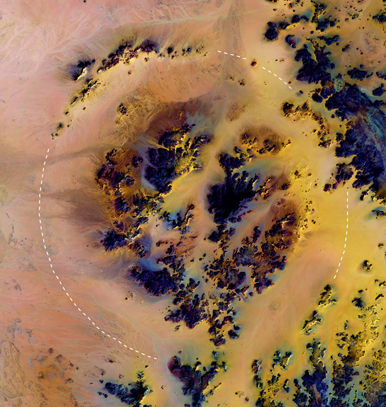Sahara’s largest crater revealed
Find may solve 75-year-old mystery of desert glass


Farouk El-Baz, a research professor and director of BU’s Center for Remote Sensing, may have solved a mystery that has baffled geologists for nearly 75 years, and solved it in a big way.
In 1932, a British scientific expedition to the Sahara Desert discovered small chunks of a translucent yellow and green glass, known as desert glass. Only one thing could have produced the extreme heat (thousands of degrees Fahrenheit) needed to melt and fuse sandstone into glass — the impact of a meteorite. But in that lonely stretch of Egyptian desert near the Libyan border there were no craters to be found.
Two weeks ago, El-Baz was looking at satellite images of an area about 50 miles from the desert glass site, and there, obscured by sand deposits from tens of millions of years and erosion from wind and two ancient rivers (now dry), was the biggest crater ever found in the Saraha. The bowl measured about 19 miles from rim to rim, big enough to fit all of Cairo inside it. Until then, the largest known crater in the Sahara, measuring about 7.5 miles in diameter, was in Chad.
Ironically, El-Baz made his discovery shortly after he had helped a British film crew make a documentary about the mystery desert glass.
“Good God, how did I miss this?” El-Baz remembers thinking when he found the crater, which he named Kebira, or “large” in Arabic. The perplexing obscurity of something so large being unobserved for such a long time may be partially explained by exactly that — its size. Craters as large as Kebira are nearly impossible to recognize without the advantage of the big-picture view of satellite images. Another possible explanation, says El-Baz, is the distance of the point of impact from the evidence of the impact. The desert glass, the first clue to the mystery, was many miles away from the crater.
Also, says El Baz, there is the working of geologic time. “It is quite old,” he says. “It has undergone severe erosion, and a great deal of the rim has been obliterated.”
While the crater’s discovery may mean that it’s back to the drawing board for the British film crew, it’s just the beginning for El-Baz. He is now organizing an expedition to revisit the site and look for evidence to eliminate any doubts about the link between the crater and the glass. He hopes to get under way by the end of the year.
“We need to get samples to prove that the sandstone here was shocked by an impact, to see if there is more evidence of the shock melting rock,” he says. “This has been a mystery for far too long."